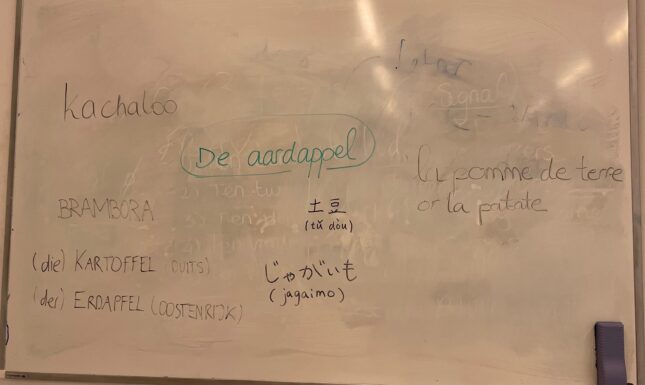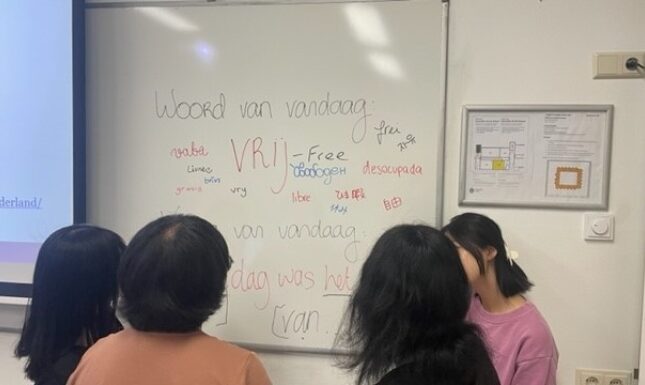Multilingualism in the classroom
Carmen Kleinherenbrink shares her experiences using multilingualism as a tool for Dutch vocabulary learning.
On December 1st, the Language Learning Resource Centre (LLRC) hosted a roundtable discussion on multilingualism. During this event, teachers shared their classroom experiences and discussed facts, misunderstandings, and practices of the language classroom. I teach classes as part of the BA program Dutch Studies/Nederlandkunde, and so I was very excited to join this roundtable event.
As language teachers, we discussed questions like how we define second language acquisition when we know students are learning it as a third, fourth or fifth language. Does using a second language hinder learning a third language? Or does a one-language model works best for learning because there’s less confusion, more time-on-task for the target language and no loss of control for the teacher? And do we allow or apply translanguaging in our classrooms?
During our discussions we also shared our experiences and specific practices we use in our language-teaching classes. In this context, I talked about a teaching activity I use called ‘Word of the Day’.
'Word of the Day'
Multilingual backgrounds are expected to affect learning development on an individual level and communicative interactions on a group level. In the BA program Dutch Studies/Nederlandkunde, students from all over the world learn about the Dutch language and culture. My classroom is an especially diverse and international classroom. I find that ‘Word of the Day’ offers a great opportunity for learning new vocabulary while, at the same time, using students’ multilingual skills and increasing their intercultural competence.
How does ‘Word of the Day’ work?
1. During the first part of the class:
Ask one student to pick the word of the day from the study material for that day. This word should answer the question: Which word do you find most interesting/difficult/important to learn based on its meaning or pronunciation?
2. During the break:
Write (or hang) the Word of the Day on the board and let students write that word in their native language(s) or another language they know
3. After the break:
Using the target language, briefly discuss the Word of the Day:
a) the pronunciation
b) the morphology, word family, associations, etymology in the target language
c) the links to the other languages/words on the board: cognateness, word formation, and pronunciation
This activity teaches students a strategy to learn a new word by creating connections to the words from their native and additional languages. The strategy highlights that it is important to identify cognateness between languages, as research shows that cognateness enhances vocabulary learning.[1]
For example, the group came up with relations for de aardappel (potato, in English) with the Austrian German word der Erdapfel and the French word la pomme de terre. This example shows that even geographical variation within languages can be helpful. It should be mentioned that the beginners' course requires learning 50 new words per day, so this activity is done in only two out of the five classes per week. For this reason, the ‘Word of the Day’ should be practised by the individual students themselves, outside the classroom.
Why use ‘Word of the Day’?
Inside the classroom, this daily practice increases three important affective components of the learning process: the so-called ‘willingness-to-communicate’, enjoyment, and self-confidence. [2]
The habitual activity of multilingually discussing a ‘Word of the Day’ operates as an information gap task in which students learn more from and with each other using Dutch as the target language. This leads to engagement and laughter while stimulating negotiation for meaning, orthography, and pronunciation even between students who speak the same language. It also enables students to walk proudly and confidently to the board to write down the word in another language they know and later discuss it with their peers.


Multilingualism in the language classrooms at Leiden University
During the roundtable discussion, some educators discovered that they instinctively already apply translanguaging and multilingualism in their classes, both at the beginner and advanced levels, and across language, theoretical, and methodological courses. For instance, when students read about a new theory in their second language, they are allowed to discuss it in a language that they prefer.
This trend might also stem from classrooms becoming less teacher and more student-centered, which is positive because learning in smaller groups is more beneficial to language acquisition than teacher-fronted instruction. [3] It is also important to consider this when addressing the perceived downsides of English-taught study programs. These programs are never and will never be completely in English, as multilingualism is increasingly, either explicitly or implicitly, encouraged as the norm. After all, nowadays most teachers are multilingual themselves!
Notes
- Each 'Word of the Day' is additionally published on the study program's Instagram page.
- The LLRC unites all language teaching professionals working at Leiden University.
References
[1] Peters, E., & Webb, S. (2018). Incidental vocabulary acquisition through viewing L2 television and factors that affect learning. Studies in Second Language Acquisition, 40(3), 551-577. https://doi.org/10.1017/S02722...
[2] Van Batenburg, E.S.L., Oostdam, R.J., Van Gelderen, A.J.S., Fukkink, R.G., & De Jong, N.H. (2019), Oral Interaction in the EFL Classroom: The Effects of Instructional Focus and Task Type on Learner Affect. The Modern Language Journal, 103, 308-326. https://doi.org/10.1111/modl.1...
[3] Doughty, C., & Pica, T. (1986). “Information gap” tasks: Do they facilitate second language acquisition?. TESOL quarterly, 20(2), 305-325. https://doi.org/10.1177/136216...


